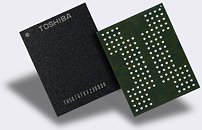Tuesday, July 4th 2017

Toshiba's 768 Gb 3D QLC NAND Flash to Match TLC's Program/Erase Cycles
Not all news coming out of Toshiba is bad or somewhat bad. The Japanese giant still is one of the biggest players in the NAND semiconductor business, no matter the recent woes. Even more recently, though, Toshiba announced they had developed quadruple level cell NAND memory, which should improve density and, therefore, reduce the price/GB ratio on future consumer products, such as SSDs. However, each increase in the number of cell levels bring concerns regarding not only performance, but especially durability, since a higher number of states per cell increases the voltage steps that are applied to it (SLC NAND dealt with two voltage states, MLC with four, TLC with eight voltage states, and QLC will handle 16 of these.) This tends to make errors more common, and the cell's longevity to be compromised due to the amount of variation in its states, which means more powerful error correction techniques must be employed.According to Toshiba, its 3D QLC NAND targets around ~1000 program/erase cycles, which is close to TLC NAND flash. This is considerably higher than the amount of P/E cycles (100 - 150) expected for QLC by the industry, which means the company has achieved what many thought difficult. Toshiba has begun sampling of its 3D QLC NAND memory devices earlier this month. everything points to mass production on late 2018, early 2019, though, which means we still have a long way to go until we see this technology implemented. This won't be the one to save us from escalating NAND prices; we'll have to look to other, more market and supply-and-demand based factors instead.
Source:
Anandtech


16 Comments on Toshiba's 768 Gb 3D QLC NAND Flash to Match TLC's Program/Erase Cycles
There's big money to be made, for sure, but you have to cough up a huge amount before you can cash in.
Good for you, because everyone else didn't. And it's still a mystery how did they manage that.You and me both, bro.
The Intel enterprise drives have endurance from a few TB to several PB, the DC 3700 being a prime example. The drives themselves are based on the same NAND AFAIK, though something like a DC 3700 will have better binning however error correction, controller et al have a far bigger role to play in making it more reliable. Toshiba says they have something better than LDPC for EC, seems like that also has a huge role in driving the endurance up.
Plus, I don't recall anyone ever detecting endurance differences for the same NAND driven by Silicon Motion, Phison or SandForce.
Third party NAND & third party controller, with tuned (custom?) firmware & 5 years warranty. I'll still maintain that RAW NAND is last on my list of things that make certain SSD's great, or reliable, though binning definitely helps & the type of NAND e.g. 3D vs planar.
But that's just my theory.